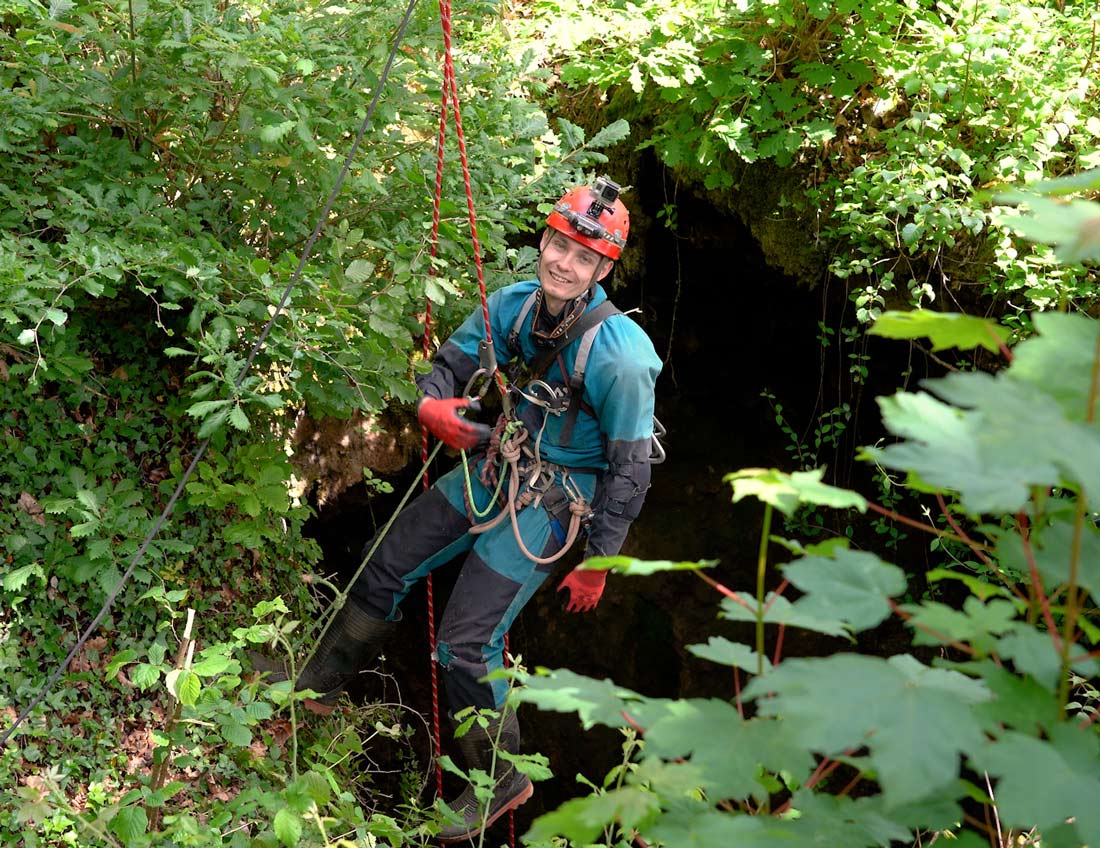Cornwall’s Last Underground Frontier
Mine Exploration in southeast Cornwall. In May 2022, we had a rare invite to explore Okel Tor mine by its owner, Nick. Taking us right to the limits of Cornwall and demanding a technical approach to exploration, join us as we attempt to unlock the secrets of this previously unexplored mine.
Unknown Cornwall
It was a calm, crisp morning in May, to which I awoke with a nervous excitement in the pit of my stomach. The car was packed, gear ready, lunch made; all that was left was to set off and start another journey exploring one of Cornwall's abandoned mines.
I knew my first stop was to meet my Cornwall Underground Adventures partner, Matt, at Starbucks. Then we would both head up to Newquay to meet our old friend, mine exploration guru, and expert rope access technician, Pat. From there, we would all travel together, as a team, right to the edge of the county to explore the unknown and discover what lies hidden beneath this forgotten corner of Cornwall.
Everyone has heard of the world-famous Cornish tin mines. However, if it was tin that made Cornwall famous it was actually copper that made us rich. Cornish mining aficionados amongst us will have doubtlessly all heard about the “Richest square mile on Earth” (Gwennap, St. Day, and Chacewater) or perhaps even the legendary story of Dolcoath Mine’s transition from copper to tin production right on the brink of its financial collapse.
The Tamar Mining District
In our last blog article, we even discussed the less well-known, but still world-famous submarine mines of West Cornwall. However, there remains a somewhat forgotten piece of the Cornish mining jigsaw, which all too frequently escapes public notice.
This is the Tamar Mining District, a few square miles that perhaps contributed more to Victorian copper mining than anywhere else in the world. Its history deserves to be remembered and in this short article, I hope to introduce you to some of its wonders by our hands-on exploring of it for real, deep underground.
We arrived at Calstock at just gone 10am. To get here we had already driven past several of Cornwall’s richest mining districts; Goss Moor near Saint Austell, Caradon near Liskeard, and finally passing Callington and Kit Hill, to reach the group of mines to which Okel Tor belongs.
Passing by Hingston Down mine on our left, we turned right at Drakewalls, another famous mine, to take the winding B road towards the Devon border. Unbeknownst to most travellers here, is the labyrinth of man-made tunnels that still exist beneath the charming country scenery. However, it was this dark and long-forgotten world that was to be the object of our journey.
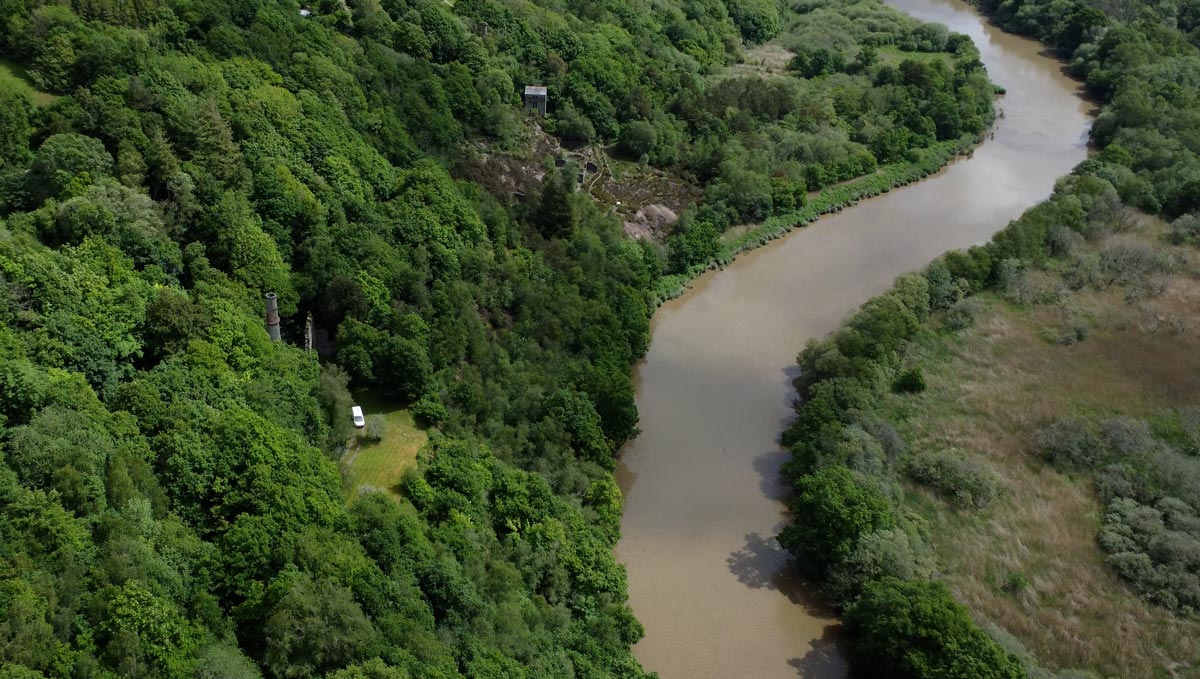
Now we were in a quiet back lane winding its way through a steep and densely forested hillside, with the lofty deciduous flora occasionally giving way to breath-taking vistas across the Tamar Valley. After an hour’s journey, we had finally reached the edge of Cornwall.
Suddenly, a tight hairpin took us off-asphalt and down a steep gravel track. Through a hole in the tree canopy we could finally see the lay of the land. What lay before us was a rich and dense network of alpine tracks that wove their way into a hillside of even richer ruined buildings and old chimneys. These were the rural and remote remains of a brief Cornish Klondike; a gold rush but for copper. A final hairpin and an open gate took us to a well-hidden collection of refurbished dwellings; we had finally arrived at Okel Tor mine.
Standing upon the lusciously green, grassy terrace gazing upon the otherwise steep, wooded hillside, we felt like travellers to an oasis. A paradise of quiet and salubrious seclusion with breath-taking views across the Tamar Valley to Devon and beyond. Amongst such a quixotic landscape of ground works, industrial ruins, and chimney stacks, we were as if toy soldiers had arrived in a model village.
A Mine Explorer’s Dream
We were greeted by two old friends who were staying there for the week, Anne and Dave, and the site owner, Nick. Since acquiring the site in the 1990s, Nick had seen it listed as a scheduled monument to ensure its protection, then worked tirelessly to stabilise collapsing structures and even succeeded in renovating the mine’s old ruined count house and Smithy which he now runs as perhaps Cornwall’s most unique and picturesque Airbnb.
Besides the chimneys, ruined engine houses and dressing floors, there was one last feature of the site which had yet to give up its secrets: the old mine engine shaft, fenced and forgotten but still wide open and unexplored in front of the ruined engine house. It is for this that Nick had very kindly invited us to Okel Tor, and for this we had been waiting for several weeks in excited trepidation to explore. It was a mine explorer’s dream.
All good exploration starts with homework. In the case of Cornish mining there is a remarkably rich historical, documentary, and manuscript record, from which to undertake one’s research. Cornwall Underground Adventures is not just a team of explorers and expert underground guides, but also a partnership of researchers with a passion for really getting to the bottom of what mining meant to Cornwall. Puns very much intended, this of course had us starting our research into Okel Tor mine long before the fieldwork began.
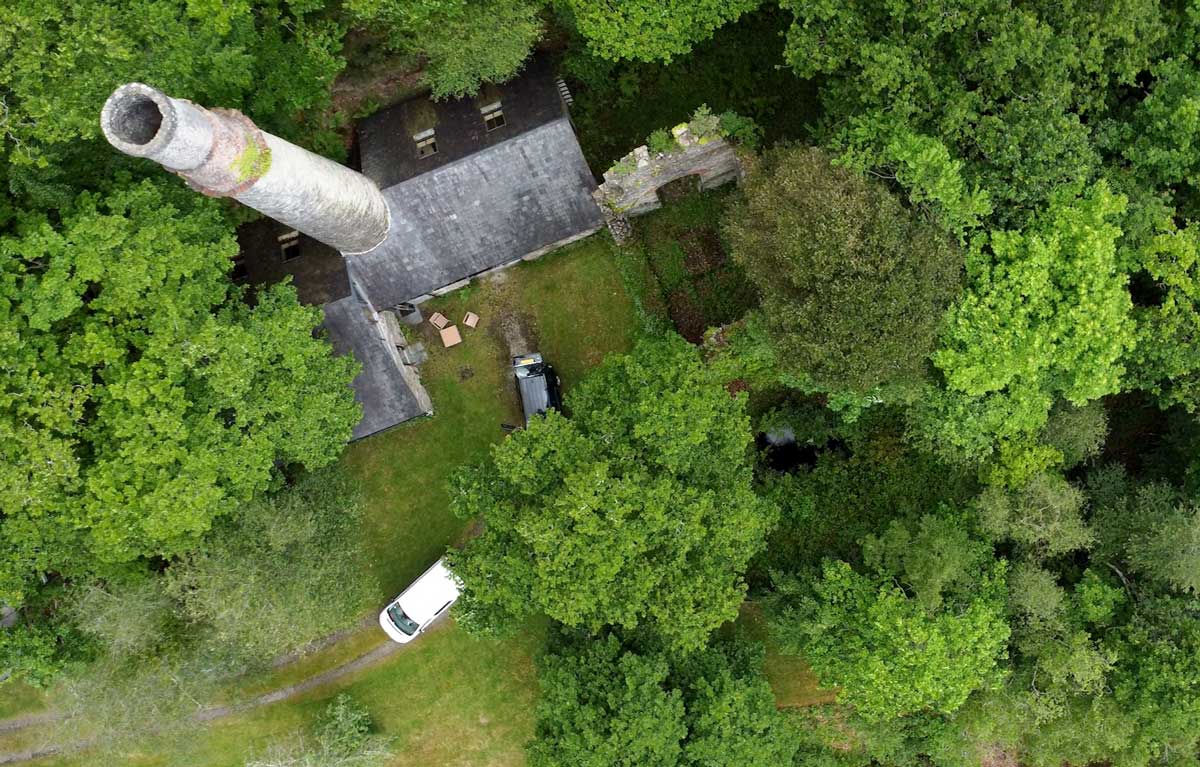
From the offset we knew that prospects were high from mines so well situated as this. Okel Tor is beside the river Tamar which, with its steep, high banks where ideal territory for the driving of adit tunnels. Where they survive today, they present some of the best exploration potential for adventurers such as ourselves. Also, a quick glance at historic Ordnance Survey mapping shows a number of potentially open mineshafts in the vicinity. However, the next step was to take our study a little deeper.
The Cornish archives are full of old mine maps, at least 4000 of them. As it so turns out, there are actually over a dozen old map sheets of Okel Tor Mine spread out across six different collections. Upon viewing these I could barely contain my excitement, for one of them dated 1867 (MRO/R68), showed a tunnel from the mine going right through the hillside in where the river Tamar meanders such that the Harewood peninsula, Calstock, is formed.
The miners, daring and adventurous folk as they were, and with not always only a profit incentive in mind, had clearly spotted the potential for creating a tunnel straight through the neck of the peninsula and seen about engineering this. This immediately became our objective to find: the exciting prospect of a potential through trip (in one entrance, out the other) a glittering possibility in our minds.
On a previous visit to Okel Tor in 2021 I had gone about exploring the surface remains and had tried to find the adit portal. Unfortunately, this was not possible to locate and I can only assume that it must have become blocked.
Knowing this, our objective on the day was clear: we would abseil down the main mineshaft in front of the engine house and try and access the adit level internally from the base of the shaft at water level. We guessed that this might be about 20 metres, or 60 feet, deep beneath the surface: an easy abseil in terms of height but other complications might be present.
Preparing to Explore the Mine
Exploring a new mineshaft is not always easy. It is important to take interest in all matters of safety when exploring something new for the first time. One aspect rarely considered is the quality of the air we must breathe whilst underground. This can be very poor due to oxidation reactions with minerals, or anoxic rotting of organics resulting in low oxygen levels, high carbon dioxide or both.
Therefore, it is important to take a gas meter which digitally takes readings and warns us about potentially dangerous atmospheres if we encounter them. As an aside, it may be a surprise to most people that our bodies cannot actually detect low oxygen in the air we breathe. It only detects high carbon dioxide concentrations in our blood.
This is the reason for why we can easily pass out without knowing at high altitude, but if we try and hold our breath, thereby increasing our blood CO2, we feel a burning urge to breathe. It is also the reason that low oxygen atmospheres underground can be so dangerous and why we must be so cautious.
The other most dangerous aspect of exploring a new mineshaft is the potential for falling rocks. The risk here is obvious and manifold. However, it can be easily avoided with care and preparation by making sure loose rocks are attached before descending or avoided entirely.
Very soon we realised that this would be our main problem with Okel Tor’s engine shaft; the original shaft capping, just some railway sleepers covering the otherwise large open hole had only partly collapsed and left a dangerous hot mess of soil, tree roots and small boulders perched, ready to fall down the shaft on the unlucky explorer, should he or she disturb them.
It was clear that to explore the mineshaft safely we must minimise the time we spent hanging there by our ropes and most importantly, avoid the ropes dislodging any of the precariously perched stones as we have abseiled or climbed.
It was for exactly this reason that we had brought Pat along on the team. As an expert rope access technician, a daring plan was hatched whereby we would distantly anchor the ropes, which would in turn pass through the bob window of the engine house then down the shaft in-front. A second line, not for the purposes of our abseiling, but as a deviation would then be installed opposite from higher up in an adjacent tree.
This would be attached via a pulley to the main abseil rope. Tension could be applied and this would pull our abseil ropes out away from the dangerously loose edge of the shaft and three hanging space in the middle, thereby avoiding the threat of any loose rocks.
Whilst Pat prepared the ropes, I hammered in some 1.2 metre, rebar stakes into the ground behind the engine house to act as our main anchor points, then I climbed the tree with a view to fixing the deviation rope on the opposite side of the shaft. This achieved, all that was left was for Pat to begin his rope wizardry and create the tensioning system.
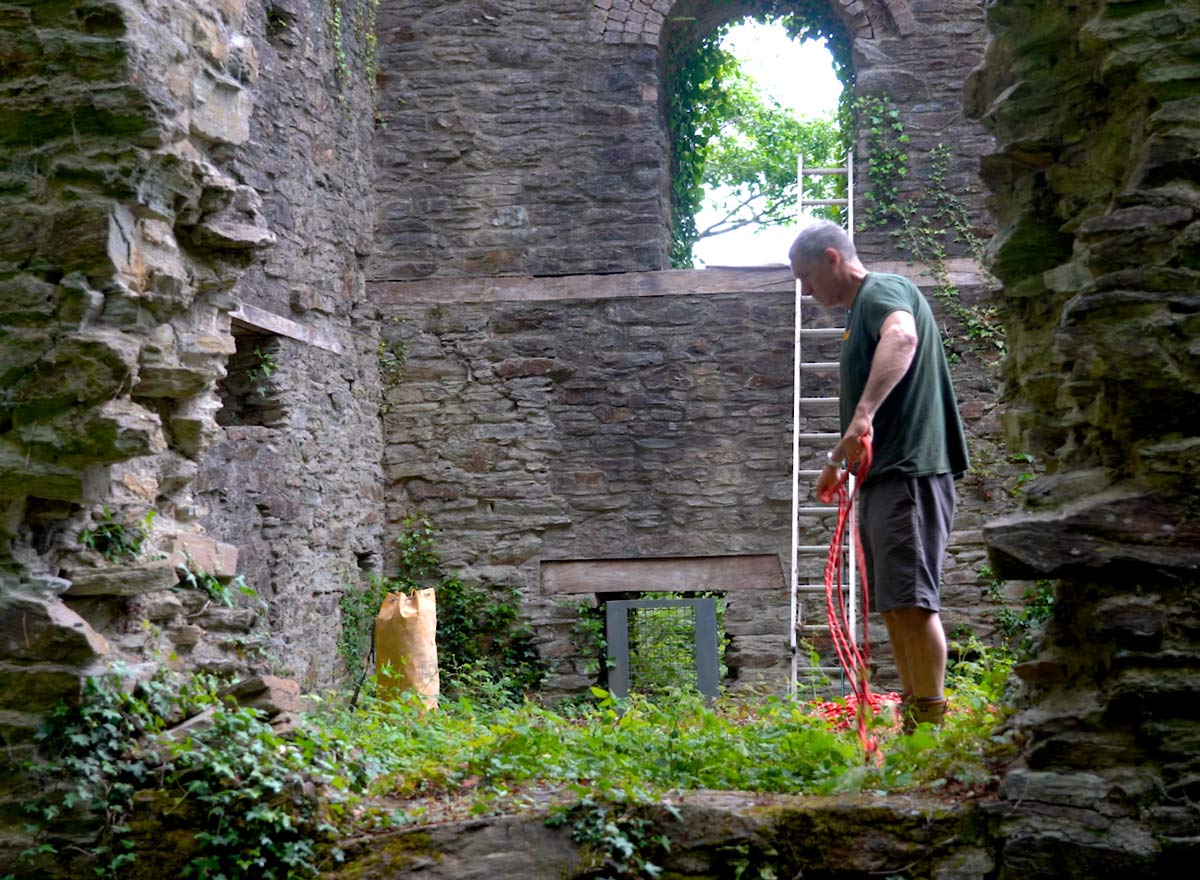
The Mathematics of Ropes
All that is necessary to understand the mathematics of how ropes work is A-level mechanics. The static load experienced by an anchor is just the weight (force due to gravity) of the explorer hanging off it. As human beings we tend to care quite a lot about our own safety, and so in scenarios where falling is not an option, we have two principles: load-sharing and redundancy.
Even if one anchor might be enough, we installed two: therefore, if one were to fail the system will be fail-safe rather than fail-deadly. We also use two or more anchors because this allows us to minimise the force applied to every individual anchor by sharing the load across them as a whole. With two anchors supporting the same weight, each one is only doing half of the work. However, depending on how we rig ropes, this is not always true.
If a weight is hanging from a rope, the force that the anchors experience is due to the tension in the rope created by the weight of the explorer or object. If one thinks about it, the system looks like a pair of triangles, the centre point being where the two ropes from each independent anchor join and then descend down to the explorer who is hanging.
What this means is that we can use trigonometry, the ancient Greek art of understanding how angles relate to triangles, to calculate the respective forces on each anchor depending on the angle created between them by the ropes.
We use one of the earliest trigonometric identities that we all remember from school: cosine or the relationship between the adjacent and hypotenuse sides of a triangle in relation to its angle. If we assume that the downward force, in this case the weight of the explorer, is the adjacent side then it stands to reason that the vertical component of the tension applied to each anchor is half of this divided by the cosine of half of the angle in between the two ropes from the anchors as they come together to meet.
Using this formula, we can calculate how the force experienced by our anchors changes, depending on the width we make our ‘Y’-hang between them. The vector force graph is simple: angles less than 90° means that each anchor experiences between half to 3/4 of our weight, then at 120° each anchor, due to the tension in the ropes at that angle, experiences the equivalent of a whole body weight each: we’ve doubled the force just by changing the angle!
Above 120° things change very quickly; by 150° each anchor experiences twice our weight each, and as one approaches 170 or 180°, forces in excess of 5 to 10 times the downwards weight is experienced on each anchor. This is why anchors must be so much stronger for zip lines or tightropes: just a small downward force carries a huge tension to each anchor.
With this in mind, we began rigging.
Pat had carefully assessed the distance between the bob window of the engine house and the opposite tree and it looked as though the angle between the two ropes, the abseil line and the deviation, would be 90° or less. This was ideal for us because it meant that the anchors themselves only experienced 3/4 of our downward weights. Happy days.
Next up was arranging the deviation itself. The plan we had in mind called for us to arrive at the start of the shaft edge and then be pulled into position hanging in the middle of the shaft by the deviation itself (it would usually be static and we’d just clip in).
However, to do this, and thereby increase the angle formed between the two ropes, would mean Pat would be hauling almost our whole body weights each. Even as fit and strong mine explorers, this was out of the question and so we needed to again use the age-old mathematical art of mechanical advantage.
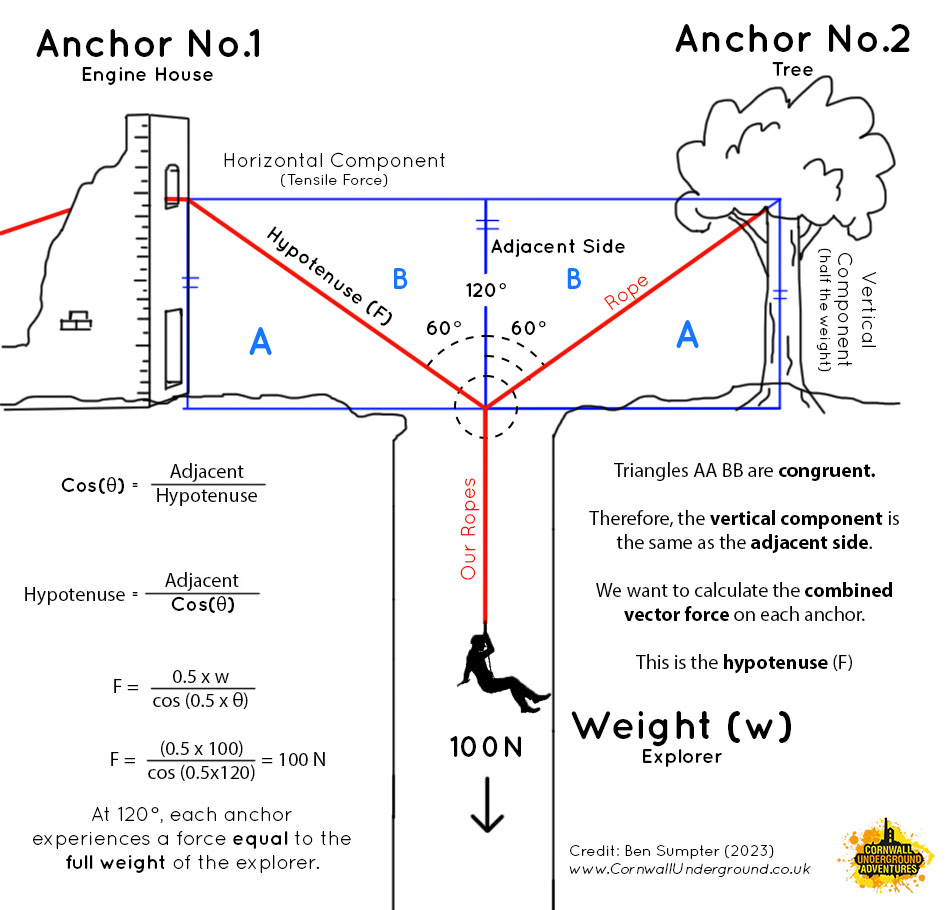
Ancient Engineering Ingenuity
Have you ever wondered how people in olden days were able to lift such heavy things as stones for statues, heavy cargo on ships, or even built the most incredible Greek and Roman temples? Well, it’s no surprise that human power alone cannot easily accomplish this; what is required are ropes, pulleys and intuitive understanding of mathematics.
We all understand how levers work: if the pivot is in the middle, both sides are equally easy to lift or move, this is how see-saws work at the park. However, if the pivot is placed more towards one side, one side becomes much more difficult to lift and so on.
This is a basic system of mechanical advantage: a small distance can very easily be used to move something a very great distance but a large force is required, and conversely if a large distance is used a very large weight can be lifted a small distance with a small force. The Greeks knew that given a long enough lever, they could lift the whole world if they had to.
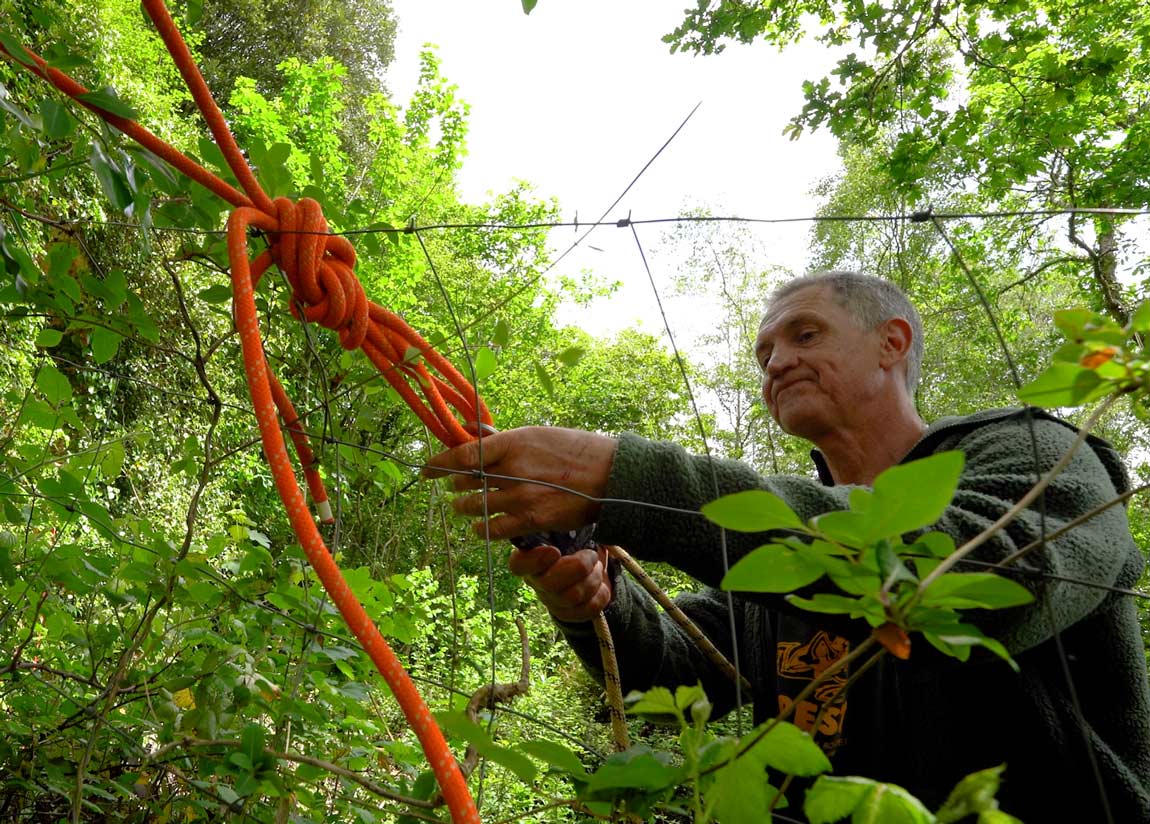
How do pulleys fit into this? Well look at it this way: if we shorten the distance that we expect to raise an object in relation to the amount of distance we are prepared to put the ropes to raise it, this is the same as the leaver scenario: just this time we’re going to do it with pulleys. By clipping a rope to a pulley and pulling downwards, ignoring friction, the force we use to lift an object will match or exceed the weight of the object we’re trying to lift.
However, if we attach a pulley to the object as well and also clip the rope to it, then as we pull on the rope the distance between the pulleys will shorten much more slowly than it would if only one pulley was used. In fact, we are pulling a lot of rope to raise the object only a short distance, thereby reducing the amount of force we have to use in the process.
The mechanical advantage is the fact that by lifting the object a shorter distance for the same amount of force on our part means we can actually lift more this way, just as if we were using a lever to do a similar task. In fact, the work that we put in, ignoring friction again, reduces continuously by a factor of the number of pulleys we use, so if we use another pulley, three in total, we can lift three times the amount of weight we could previously.
This relationship has been understood for literally millennia; the Romans understood it, the Greeks understood it, cathedrals could not have been built in the mediaeval period without it. The beautiful centuries-old ships such as the Tudor Mary Rose could not have operated without mechanical advantage systems like this. These are of course, what we now know as block and tackle, or snatch blocks.
So knowing all this maths about rationalising the component vectors of anchor forces and mechanical advantage systems, Pat set up the last stage in our rigging plan. He created a 5-to-1 mechanical advantage pulley system to tension the deviation; this would allow him to pull us in position over the mineshaft, in the process lifting equivalent to 3/4 of a body weight by himself (even more with friction included) with almost no effort involved on his part.
We were finally ready to begin exploring!
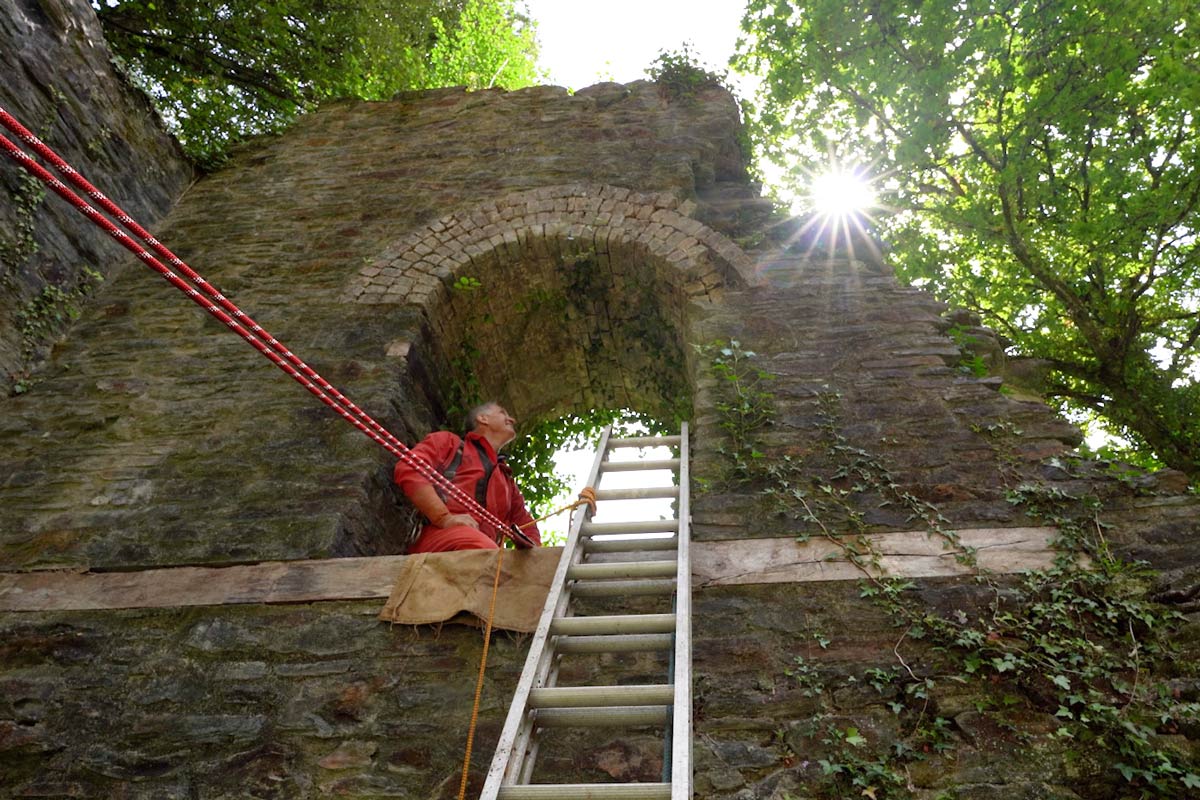
Descending the Mine Shaft
I was up first. Depending on what I found, Matt would come next and join me to explore, followed finally by Pat if it came to it. I was equipped with my gas meter, to check oxygen levels, my digital camera, a GoPro, my usual Caving SRT (single rope technique) equipment, and most importantly, nerves of steel! I got into position, rigged my Petzl Stop descender, attached my Petzl Shunt backup device onto the second rope for redundancy, and I was ready to begin the abseil.
With cameras rolling, both on me and on the drone Matt was flying, I tentatively set off down the shaft. At first it was difficult to see down because of the dense vegetation which had grown up that spring.
However, as Pat’s mechanical advantage deviation pulled me out away from the shaft collar and into free space, I got my first glimpse of the place I will be exploring. Beneath me was a vast open hole some 10ft wide by 15ft long. Safely clipped to the rope, there was nothing but thin air beneath my two feet as I looked down the sheer-sided descent of some 20 metres.
Not a place to be stuck if you’re scared of heights! The feeling of free space all around me was exhilarating; I was well prepared, my equipment was good, and my mind was focused. The first job was to clear any dangerous rocks within reach before my descent; this would be an easy task to eliminate and only took a couple minutes. With this complete, finally I was ready to descend the mine shaft in earnest.
Controlling the rope with my right hand and gently depressing the lever of my Petzl Stop with my left, I started to slowly and gently abseil down the mineshaft. All around me the sounds of the outside world ebbed away, being replaced by the echoes of drips and the sound of running water.
Bright sunshine faded to an early but perpetual twilight with every meter deeper I went. Looking up I could see overhanging greenery creating a luscious vignette of the shaft top, framing it as if it were a painting. Downwards, beneath my feet floating in free space, I could see the water level of the shaft reflecting softly in the distant daylight above. I descended deeper.
After about a minute or so of abseiling I had reached the bottom, the flooded water level of Okel Tor Mine. The shaft itself was over 100 fathoms deep (over 200 metres!). However, this full depth was only accessible whilst the steam pumping engine was working to keep the mine dry. Since its abandonment in 1888, the water had been allowed to rise up to the lowest point it could drain naturally under gravity: this was the adit level that I had reached.
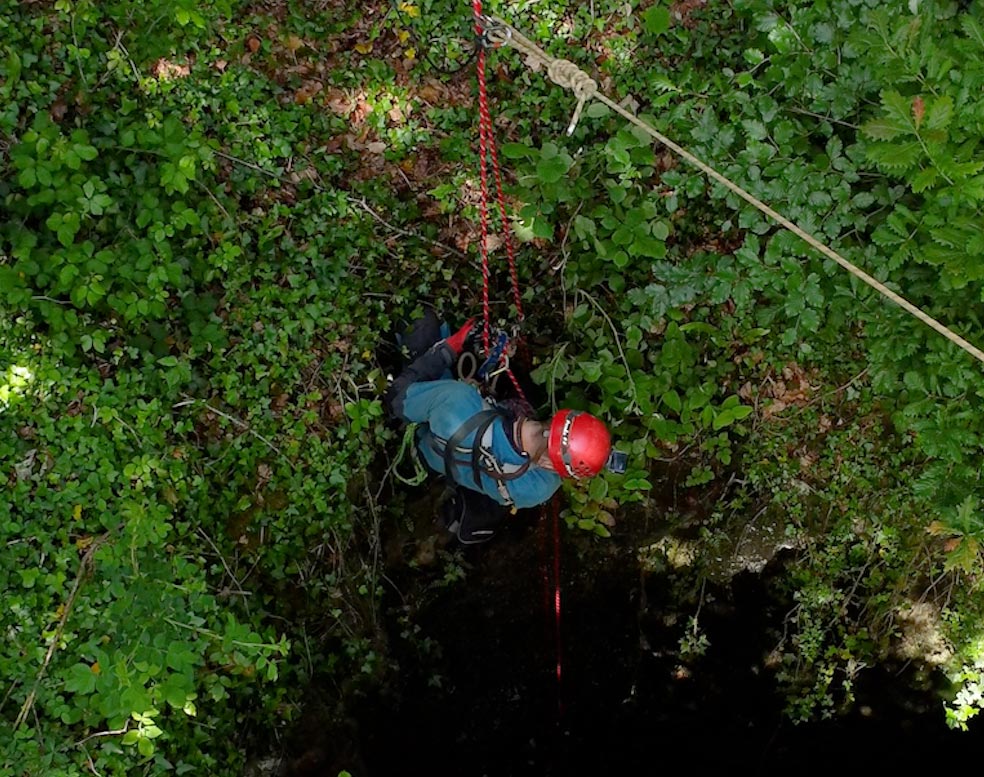
As the water level came into view, I knew that all of our hopes of discovery an exploration depended on this one small tunnel that we knew existed from the old maps, but had hoped to find now for real. If we could find and get inside, perhaps it could be the key to the hillside and allow us to explore its honeycomb labyrinth of workings deep within. Now was the moment, everything had come to this.
Arriving at the water level and turning on my head torch, I gazed forward hoping to see our tunnel come into view. However, instead I found myself gazing at a large ochre dam some 6ft high and just as much wide! What on earth had happened? Looking around there was nowhere else a tunnel could exit from the shaft, and beneath me was just flooded water.
Was the water backed up and the tunnel actually beneath me, flooded? No, the shaft was exactly the right depth to water level, it couldn’t be. Instead, this must be the adit level itself, just filled to the roof with a thick ochrous mud. How frustrating! So close but yet so far.
This is perhaps not so surprising a turn of events. Knowing that the portal was choked outside the mine probably meant that water had backed up inside; Water that was thick with ochrous mud from the mineral vein, thus depositing said mud in the tunnel, totally filling it to the roof. Many mines in the area actually sold ochre as part of the mineral produce, so it is not surprising that here at Okel Tor it also existed in abundance.
If not surprising, it was an unfortunate turn of events. However, being still in a very dangerous environment inside the mineshaft I was most interested to leave as quickly as possible and relay the findings to the team up at surface. So, I changed into ascent and began the climb back up and out of the 20-metre mineshaft.
Exploring Cornwall, One Mine at a Time
As I arrived back into daylight it felt, as it always does, a bit like being reborn. The warmth of the sunshine reminds you that you’re alive and that you have just conquered a major obstacle, indeed most people’s worst nightmares.
It’s certainly true that we didn’t discover the amazing tunnels going right through the Harewood peninsula of Calstock on this occasion, but that’s true exploration for you. We explore not because we know what to expect, because it is the unknown. And as explorers, it will always be just as much about the journey as the discovery.
Matt descended after me to see for himself, but unfortunately couldn’t find any leads I had missed. With him safely back at surface and the ropes derigged, Anne and Dave had prepared lunch for us; a lovely way to round off the exploration and a lovely conclusion to our efforts. Having thanked Nick for the invite to explore his mine, we set off back home to West Cornwall, food in our bellies and yet another Cornish mine finally ticked off the list.
Here’s to our next Cornish mine exploration. Who knows whether its underground discoveries will be big or small. Perhaps even just a 20-metre shaft to water and a blocked tunnel. In any event, stay tuned!
